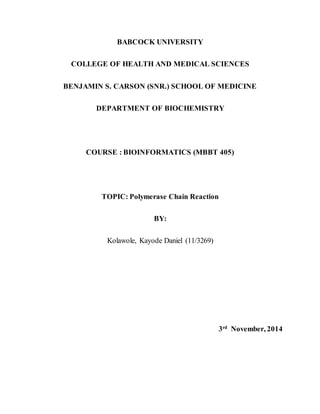
Polymerase Chain Reaction
- 1. BABCOCK UNIVERSITY COLLEGE OF HEALTH AND MEDICAL SCIENCES BENJAMIN S. CARSON (SNR.) SCHOOL OF MEDICINE DEPARTMENT OF BIOCHEMISTRY COURSE : BIOINFORMATICS (MBBT 405) TOPIC: Polymerase Chain Reaction BY: Kolawole, Kayode Daniel (11/3269) 3rd November, 2014
- 2. Definition Polymerase chain reaction, (PCR), a technique used to make numerous copies of a specific segment of DNA quickly and accurately. The polymerase chain reaction enables investigators to obtain the large quantities of DNA that are required for various experiments and procedures in molecular biology, forensic analysis, evolutionary biology, and medical diagnostics (Gloria et al., 2014) PCR (Polymerase Chain Reaction) is a revolutionary method developed by Kary Mullis in the 1980s. Because DNA polymerase can add a nucleotide only onto a preexisting 3'-OH group, it needs a primer to which it can add the first nucleotide. This requirement makes it possible to delineate a specific region of template sequence that the researcher wants to amplify. At the end of the PCR reaction, the specific sequence will be accumulated in billions of copies (amplicons). DNA synthesis at one primer is directed toward the other, resulting in replication of the desired intervening sequence. Also needed are free nucleotides used to build the new DNA strands and a DNA polymerase, an enzyme that does the building by sequentially adding on free nucleotides according to the instructions of the template. Components of PCR DNA template The sample DNA that contains the target sequence. At the beginning of the reaction, high temperature is applied to the original double-stranded DNA molecule to separate the strands from each other.
- 3. DNA polymerase A type of enzyme that synthesizes new strands of DNA complementary to the target sequence. The first and most commonly used of these enzymes is Taq DNA polymerase (from Thermis aquaticus), whereas Pfu DNA polymerase (from Pyrococcus furiosus) is used widely because of its higher fidelity when copying DNA. Although these enzymes are subtly different, they both have two capabilities that make them suitable for PCR: 1) they can generate new strands of DNA using a DNA template and primers, and 2) they are heat resistant. Primers Short pieces of single-stranded DNA that is complementary to the target sequence. The polymerase begins synthesizing new DNA from the end of the primer. Nucleotides (dNTPs or deoxynucleotide triphosphates) Single units of the bases A, T, G, and C, which are essentially "building blocks" for new DNA strands. RT-PCR (Reverse Transcription PCR) is PCR preceded with conversion of sample RNA into cDNA with enzyme reverse transcriptase. How PCR works PCR is a three-step process that is carried out in repeated cycles; The initial step is the denaturation, or separation, of the two strands of the DNA molecule. This is accomplished by heating the starting material to temperatures of about 95° C (203° F). Each strand is a template on which a new strand is built. In the second step the temperature is reduced to about 55° C (131° F) so that the primers can anneal to the template.
- 4. In the third step the temperature is raised to about 72° C (162° F), and the DNA polymerase begins adding nucleotides onto the ends of the annealed primers. At the end of the cycle, which lasts about five minutes, the temperature is raised and the process begins again. The number of copies doubles after each cycle. Usually 25 to 30 cycles produce a sufficient amount of DNA. In the original PCR procedure, one problem was that the DNA polymerase had to be replenished after every cycle because it is not stable at the high temperatures needed for denaturation. This problem was solved in 1987 with the discovery of a heat-stable DNA polymerase called Taq, an enzyme isolated from the thermophilic bacterium Thermus aquaticus, which inhabits hot springs. Taq polymerase also led to the invention of the PCR machine. Because DNA from a wide range of sources can be amplified, the technique has been applied to many fields. PCR is used to diagnose genetic disease and to detect low levels of viral infection. In forensic medicine it is used to analyze minute traces of blood and other tissues in order to identify the donor by his genetic “fingerprint.” The technique has also been used to amplify DNA fragments found in preserved tissues, such as those of a 40,000-year-old frozen woolly mammoth or of a 7,500-year-old human found in a peat bog.
- 5. Limitations of PCR and RT-PCR The PCR reaction starts to generate copies of the target sequence exponentially. Only during the exponential phase of the PCR reaction is it possible to extrapolate back to determine the starting quantity of the target sequence contained in the sample. Because of inhibitors of the polymerase reaction found in the sample, reagent limitation, accumulation of pyrophosphate molecules, and self-annealing of the accumulating product, the PCR reaction eventually ceases to amplify target sequence at an exponential rate and a "plateau effect" occurs, making the end point quantification
- 6. of PCR products unreliable. This is the attribute of PCR that makes Real-Time Quantitative RT-PCR so necessary (NCBI, 2014).
- 7. References Gloria L, Gaurav S, and Surabhi S. http://www.britanica.com/EBchecked/topic/468736/polymerase-chain-reaction. Retrieved on 28th october, 2014. National Centre for Biotechnology Information, U.S. National Library of Medicine, Betheoda MD, USA. Http://www.ncbi.nlm.nih.gov/probe/docs/techpcr. Retrieved on 28th October, 2014.
